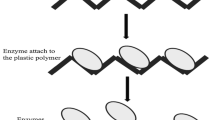Abstract
To assess the capacity of the natural environment for degrading PHB/V, the film-MPN method proposed previously was modified to estimate the numbers of PHB/V degrading microorganisms (degraders) in various environments. The First-Order Reaction (FOR) model was used to determine the appropriate incubation period for the method. Numbers of aerobic PHB/V degraders were estimated in garden soil, paddy field soil, farm soil, river bank soil, infertile garden soil, river water, activated sludge, and seawater by the film-MPN method. Results were compared with those estimated by the clear-zone technique and showed that the film-MPN method was suitable for estimating the numbers of PHB/V degraders in the environments tested. On the other hand, biodegradability of injection molded PHB/V samples was investigated in several kinds of environments. The changes of weight were studied and results showed that biodegradability of PHB/V related to the numbers of PHB/V degraders in similar ecosystem in different regions. In different environments the biodegradability of PHB/V not only related to the number of PHB/V degraders, but also depended on whether there were conditions for the PHB/V degraders to grow and proliferate easily in the environment.
Similar content being viewed by others
References
M. Lemoigne (1926) Bull Soc. Chim. Biol. (Paris) 8 770–782
A. Steinbüchel H. E. Valentin (1995) FEMS Microbiol. Lett. 128 219–228
A. Chowdhury (1963) Arch. Mikrobiol. 47 167–200
F. P. Delafield M. Doudoroff N. J. Palleroni C. J. Lusty R. Contopoulos (1965) J. Bacteriol. 90 1455–1466
J. Mergaert A. Webb C. Anderson A. Wouters J. Swings (1993) Appl. Environ. Microbiol. 59 3233–3238
A. Schirmer D. Jendrossek H. G. Schlegel (1993) Appl. Environ. Microbiol. 59 1220–1227
H. Brandl R. Bachofen J. Mayer E. Wintermantel (1995) Can. J. Microbiol. 41(Suppl 1) 143–153
D. Jendrossek A. Schirmer H. G. Schlegel (1996) Appl. Microbiol. Biotechnol. 46 451–463
C. R. Hankermeyer R. S. Tjeerdema (1999) Rev Environ. Contam. Toxicol. 159 1–24
A. Steinbüchel (1996) in H. J. Rehm et al. (Eds), Biotechnology, Vol 6, VCH, Weinheim, pp. 405–451.
D. Jendrossek I. Knoke R. B. Habibian A. Steinbüchel H. G. Schegel (1993) J. Environ. Polym. Degrad. 1 53–63
B. H. Briese D. Jendrossek H. G. Schlegel (1994) FEMS Microbiol. Letter 117 107–112
J. Mergaert, A. Schirmer, L. Hauben, M. Mau, B. Hoste, K. Kersters, D. Jendrossek, and J. Swings (1996) Int. J. Syst. Bacteriol. July, 769-773.
M. Matavulj H. P. Molitoris (1992) FEMS Microbiol. Rev. 103 323–332
H. Nishida Y. Tokiwa (1993) J Environ. Polym. Degrad. 1 227–233
H. Nishida S. Suzuki Y. Tokiwa (1998) J Environ. Polym. Degrad. 6 43–58
D. M. Horowitz J. K. M. Sanders (1995) Can. J. Microbiol. 41 (Suppl. 1) 115–123
B. A. Ramsay I. Saracovan J. A. Ramsay R. H. Marchessault (1994) J Environ. Polym. Degrad. 2 1–7
R. H. Marchessault F. G. Morin S. Wong I. Saracovan (1995) Can. J. Microbiol. 41 (Suppl.1) 138–142
A. Schirmer C. Matz D. Jendrossek (1995) Can. J. Microbiol. 41 (Suppl. 1) 170–179
C. J. Song U. Uchida S. Ono C. Shimasaki M. Inoue (2001) Biosci. Biotechnol. Biochem. 65 1214–1217
C. J. Song S. F. Wang S. Ono B. H. Zhang C. Shimasaki M. Inoue (2002) Soil Sci. Plant Nutr. 48 159–164
C. J. Song S. F. Wang S. Ono B. H. Zhang C. Shimasaki M. Inoue (2003) Polym. Adv. Technol. 14 184–188
W. Mizuno M. Kawaguchi N. Sarukura I. Omodaka S. Takeguchi (1996) KOBUNSHI RONBUNSHU 53 513–521
W. Mizuno Y. Maeda K. Kozima T. Takamichi K. Miyabe S. Takeguchi (2001) KOBUNSHI RONBUNSHU 58 59–65
The Committee of Standard Method of Soil for Analysis and Measurement (1986) in Japan Society for Soil and Fertilizer Science (Eds), The Standard Method of Soil for Analysis and Measurement, HAKUTOMOSHYA, Japan, 70-175.
K. P. Caballero S. F. Karel R. A. Register (1995) Int. J. Biol. Macromol. 17 86–92
S. Ishikuri (1992) Japan Society for Soil Microbiology (Eds) New Compilation Soil Microbiology Experimental Method YOKENDO Tokyo 45–54
T. Hattori (1985) Rep Inst. Agric. Res. Tohoku Univ. 34 1–36
S. Ishikuri Y. Suwa T Hattori (1984) Soil Sci. Plant Nutr. 30 249–253
W. G. Cochran (1950) Biometrics 6 105–116 Occurrence Handle1:STN:280:Cy%2BD38boslU%3D Occurrence Handle15420239
Author information
Authors and Affiliations
Corresponding author
Rights and permissions
About this article
Cite this article
Wang, S., Song, C., Mizuno, W. et al. Estimation on Biodegradability of Poly (3-hydroxybutyrate-co-3-hydroxyvalerate) (PHB/V) and Numbers of Aerobic PHB/V Degrading Microorganisms in Different Natural Environments. J Polym Environ 13, 39–45 (2005). https://doi.org/10.1007/s10924-004-1214-7
Issue Date:
DOI: https://doi.org/10.1007/s10924-004-1214-7




